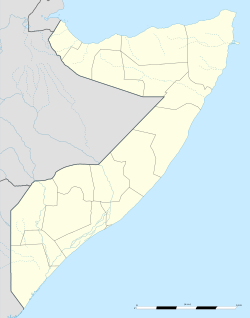Buur Heybe | |
|---|---|
Village | |
| Coordinates: 3°00′00″N 44°19′00″E / 3.00000°N 44.31667°E | |
| Country | |
| State | |
| Region | Bay |
| Time zone | UTC+3 (EAT) |
Buur Heybe, which translates to "The Hill of the Potter's Sand",[1] is a late Pleistocene and Holocene archaeological complex located in the largest granite inselberg in the inter-riverine region of the southern Bay province of Somalia approximately 180 km northwest of the capital Mogadishu. Buur Heybe has a longstanding history of archaeological research dating back to the 1930s when Paolo Graziosi carried out the first professional archaeological excavation in Somalia in the rockshelter site of Gogoshiis Qabe in Buur Heybe.[2] Further excavations by J. Desmond Clark in the 1950s and later by the Buur Ecological and Archaeological Project (BEAP) led by Steven Brandt in the 1980s have made Buur Heybe one of the best dated and closely studied archaeological sites in Somalia.
Excavations in the Buur Region ended abruptly in 1989 as the encroaching Somali Civil War threatened to engulf southern Somalia, although plans were made by BEAP to return to the Buur Region in 1990, the collapse of the Somali government effectively ended all archaeological research in Southern and Central Somalia to this day.[3] Furthermore, as war consumed Mogadishu the Somali National Museum was looted resulting in the destruction of all BEAP archaeological collections which included soil samples, lithics, and human skeletons from Buur Heybe and Guli Waabayo. Fortunately for archaeologists, the Somali Academy of Science granted BEAP approval to export much of the faunal, shell, lithic, and pottery collections from Gogoshiis Qabe, Guli Waabayo and Rifle Range Site to three United States universities prior to the collapse of the Somali government. These collections were originally curated at the University of Florida, Washington University in St. Louis, and the University of Wisconsin-Madison.[3] However, currently the majority of archaeological collections that were originally exported during the Somali Civil War are being curated at the University of Florida.
- ^ The Potters of Buur Heybe, Somalia, Tara Belkin, Steven A. Brandt, Surer Noor, Left Coast Press, Walnut Creek, Calif.: Left Coast Press, 2006, ISBN 1-59874-119-5, OCLC 76174785, retrieved 2021-10-18
{{citation}}: CS1 maint: others (link) - ^ Brandt, Steven A. (1988). "Early Holocene mortuary practices and hunter-gatherer adaptations in southern Somalia". World Archaeology. 20 (1): 40–56. doi:10.1080/00438243.1988.9980055. ISSN 0043-8243. PMID 16470993.
- ^ a b Jones, Mica B.; Brandt, Steven A.; Marshall, Fiona (March 2018). "Hunter-gatherer reliance on inselbergs, big game, and dwarf antelope at the Rifle Range Site, Buur Hakaba, southern Somalia ~20,000−5,000 BP". Quaternary International. 471: 55–65. doi:10.1016/j.quaint.2017.09.030. ISSN 1040-6182.
